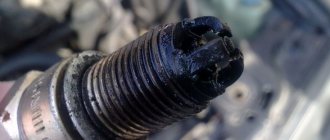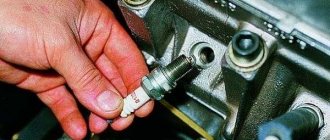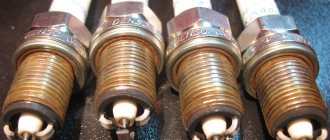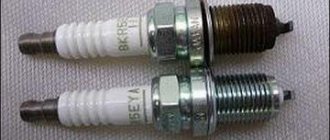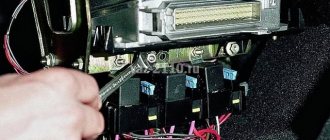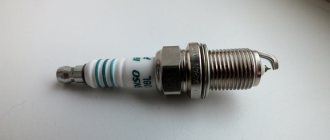During operation, the spark plug of any car is exposed to very high temperatures. In addition, the process of combustion of a mixture of fuel and air causes a chemical reaction, therefore, after intensive use, a coating appears on the working surface of the part, changing its color. A solution to the problem can be the use of candles made of materials that are resistant to both temperature and aggressive chemical influences. In addition, you can simply remove carbon deposits, returning the parts to their previous appearance and original performance.
Black plaque - what is it?
It is black carbon deposits that most often form on spark plugs. There are 2 types of black soot - the structure of the plaque also varies. If the coating has a grayish tint, there is no need to worry - this is a sign of stable engine operation.
If the electrode or threaded connections are covered with oily soot, this means that when the engine is running, too much working fluid ends up in the combustion chamber. This phenomenon has an accompanying symptom: when the engine starts, blue smoke begins to come out of the exhaust. There are several possible reasons:
- piston caps are worn out;
- the piston rings have become unusable;
- valve bushings have expired.
The appearance of black carbon deposits on spark plugs is associated with wear and tear on the components of the cylinder-piston system. The problem is solved by replacing worn parts with new ones.
Another type of resin deposit is called “velvety.” In this case there are no traces of oil. The appearance of soot deposits of this type is associated with the appearance in the combustion chamber of a TV mixture, the fuel content of which greatly exceeds the norm. Then a dry resin deposit forms. This occurs due to a malfunction of the candle - if it has ceased to produce the amount of energy necessary for ignition. Soot settles on the electrodes and never appears on the threads.
Types of soot
Spark plugs are an integral element of any car that runs on fuel. They perform two functions: they provide a spark in the combustion chamber and remove excess heat after it appears.
Problems with this element lead to incorrect engine operation. The engine starts to stall, starts every once in a while, and runs unstably. To check their operation, you just need to look at the color of the soot.
In most cases, black carbon deposits appear on the spark plugs. It can be of two varieties, by which the cause of the malfunction can be determined.
The driver should take into account that normal carbon deposits on candles are considered gray or brown. This indicates normal engine operation.
Oily black soot
If carbon deposits and oil are found on the spark plugs when unscrewing, this means that too much oil is entering the combustion chamber. Usually, at the same time, the driver notices that blue smoke is coming out of the exhaust pipe when starting. The reasons for black spark plugs lie in the wear of parts of the cylinder-piston group.
Why there is black soot on the spark plugs: reasons
Black carbon deposits on spark plugs may cover all spark-producing elements or appear only on some of them. If one element turns black, this can be associated with its malfunction. Sometimes the wire in the spark plug just burns out. But a malfunction of the cylinder corresponding to this element cannot be ruled out.
If the element is covered with soot on only one side, this indicates a poor valve fit. Also, the reasons may be a burnt-out valve or problems with the timing belt.
Uneven formation of soot is caused by a mismatch between the heat rating of the spark plug and the type of engine. If the CN of an element exceeds the established norm, only its upper part will become dark, and the body will remain white. With a low heat number, on the contrary, the color of the body will change.
When all the elements turn black at once, this is a consequence of late ignition. In this case, it is recommended to listen to the starter. If the ignition is really late, the starter makes sounds similar to knocking.
Also check the operation of the injector. If it malfunctions, the TV mixture may become excessively rich. As a result of the combustion of such fuel, a black coating is obtained. Its appearance is also associated with the following malfunctions:
- clogged air filter;
- incorrect ignition angle;
- damage to wiring insulation;
- deformation of the distributor runner or its cover;
- ignition coil defect.
Let us summarize the reasons for the appearance of carbon deposits on different types of engines.
Carburetor
Here, the formation of soot is usually associated with excessive enrichment with fuel. Unburned fuel can settle on the spark-forming elements installed on carburetor engines due to malfunctions of the carburetor or its incorrect settings.
Often problems arise due to a malfunction of the electric valve or insufficient compression in the cylinders. In this case, check the air filter, since on carburetor engines it becomes dirty somewhat faster than on injectors.
Another common cause is insufficient sparking.
Injector
Black deposits in injection units are usually formed due to increased pressure in the fuel frame. The fuel is supplied too actively and does not have time to burn out. The operation of the pressure stabilizer is disrupted.
Look at the ignition coil - it has probably failed due to an incorrect timing.
A common cause is wear on the condenser or piston rings. And finally, the spark-producing elements themselves can also break.
Light electrodes
White or light gray spark plugs in all cylinders are a sign of a lean air-fuel mixture supplied by the injector or carburetor. Moreover, the skirt, area near the electrodes and the threaded part are absolutely dry, without traces of oil.
Why is the fuel mixture supplied lean?
- lambda - the probe incorrectly informs the control unit about the amount of oxygen in the exhaust gases, the reason is sensor wear;
- faulty or clogged nozzles;
- incorrect carburetor settings or clogged fuel jets;
- insufficient pressure in the injector fuel rail;
- problems with the idle air control;
- air leakage under the manifold or in another place;
- unsuccessful chip tuning of the controller made by the owner of the car.
A lean mixture does not pose any particular danger to a running engine, but it does cause discomfort to the driver. The car accelerates slowly, pulls poorly and jerks - there is a lack of fuel. Oddly enough, the phenomenon causes increased gasoline consumption - a car enthusiast who wants to achieve better performance indicators presses the accelerator pedal harder and more often.
Note. Often the light shade of the working electrodes is explained by the type of fuel used. If the car is operated on methane or liquefied gas (propane-butane mixture), this color is considered normal.
How to get rid of black plaque?
Oil on spark-forming elements harms the ignition system. An oily film provokes overheating and the appearance of soot, which can result in complete breakdown of the electrodes. The candles will have to be thrown away.
If only one element has turned black, you can determine the malfunction by swapping it with a normal spark plug. If a serviceable element also turns black, it means that the spark generators have nothing to do with it - the fault should be looked for in the cylinder. Accordingly, if no changes occur, the candle is “to blame.”
It is necessary to regularly check the spark-producing elements and also clean them. Experts advise doing this every 10,000 km or at the next oil change. Some drivers clean with sandpaper, but this can damage the protective layer (especially in iridium spark plugs).
For cleaning you will need the following materials:
- synthetic detergent;
- disposable plastic cups (must be disposed of immediately after use);
- a fuzzy cleaning device (such as a toothbrush);
- rags.
Pour the cleaning agent into a plastic cup prepared in advance. Any surfactant will do. We fill the glass with it to such a level that the electrode part of the candle along with the threaded connection is immersed in the detergent. The elements should remain in this position for at least half an hour, but their stay in the solution can be extended to 45 minutes. At this time, a chemical reaction will occur - you can observe the process of purification of the elements.
Then we take the candles out of the glass and clean them with a brush - the electrode is the most diligent. Then wash the elements in warm, preferably running water. Finally, wipe them dry with a rag.
Possible reasons for the appearance of soot
Before answering the question of why the candles are black, you need to decide how exactly they turned black . After all, it depends on which direction to search. In particular, the candles can turn black all together, or maybe only one or two of the set. Also, the candle may turn black only on one side, or perhaps along its entire diameter. There are also so-called “wet” and “dry” carbon deposits.
It should be noted that the speed of appearance and nature of carbon deposits directly depends on existing faults (if any):
- Carbon deposits on new spark plugs begin to form after at least 200-300 km. Moreover, it is advisable to drive along the highway at approximately the same speed and engine load. This way the spark plugs will work in optimal mode, and it will be possible to more objectively assess the condition of the car’s components.
- The amount and type of soot depends on the quality of the fuel used. Therefore, try to refuel at trusted gas stations, and not drive with gasoline or similar mixtures. Otherwise, it will be difficult to establish the real cause of the appearance of soot (if it occurs).
- In a carburetor engine, the idle speed must be set correctly.
Now let's move directly to the question of why black soot appears on the spark plugs. There may be 11 main reasons :
- If you notice blackening on only one side, then most likely this is caused by a burnt-out valve. That is, carbon deposits on the spark plug fall on the side electrode from below (and not on the central one).
- The cause of black spark plugs may be a burnt-out valve. The situation is similar to the previous one. Carbon deposits may penetrate the bottom electrode.
- An incorrectly selected glow rating of a spark plug causes not only damage to it during further use, but also uneven blackening at first. If the mentioned number is small, then the shape of the soot cone will change. If it is large, then only the top of the cone will turn black, and the body will be white.
“Dry” carbon deposits on a candle
As a rule, when the ignition is set late and the air-fuel mixture is rich, the following consequences arise:
- misfires (error P0300 appears on injection engines);
- problems starting the engine;
- unstable engine operation, especially at idle, and as a result, increased vibration levels.
Diagnostics of the fuel supply system to the engine
You should check the presence of the required amount of fuel in the gas tank. An insufficient amount of it can affect further diagnostics, since a small volume of gasoline will not allow the gas pump to receive the required amount. All diagnostics should be carried out with a full gas tank.
You need to pay attention to:
- Carburetor;
- Pump;
- Idle air valve;
- Oil.
You should start checking with the pump, as this is very easy to do. It is necessary to disconnect the fuel hose from the engine and turn the starter.
The pump operates if there is fuel supply. Diagnostics can be done without starting the engine. To do this, you need to press the lever on the pump itself. A few presses are enough to create the necessary pressure.
If gasoline does not begin to pump after pumping, the pump should be replaced with a new one. There is no particular point in restoring the pump, since this component has a low price. Around 500-1500 rub.
The next step will be diagnosing the carburetor. It is not possible to do this alone. Therefore, you should ask someone to help.
With the found assistant, you need to do the following:
- Remove the air filter cover;
- The assistant needs to look into the collector;
- Step on the gas and try to start the engine.
Gasoline must flow into the manifold. If everything is so, then the system is working properly. If not, then the carburetor is broken.
In this case, you need to clean the idle air valve on the carburetor. This valve looks like a “bar” and is located on the side. It must be unscrewed and checked for dirt. The valve must be cleaned with a needle or other thin object.
If a VAZ 2109 with a carburetor does not start the first time, then the defect is clearly in the carburetor jets.
For complete cleaning you will need a special liquid and a compressor. It is also necessary to correctly configure the carburetor itself. It is very difficult to do this yourself if you do not have the proper experience.
If the VAZ 2109 has an injector and the engine does not start, then the injectors should be checked. First of all, you should check the presence of power with a multimeter. To do this, you need to measure the voltage at the contacts that are connected to the injector. If there is no voltage, then it is necessary to check the cable.
If a VAZ 2109 does not start on an injector or carburetor in winter, then one of the reasons may be the thickening of the oil in the cylinders. Because of this, the compression force drops and the engine is unable to convert the mixture. In winter, oil flows down in the cylinder from top to bottom. And when trying to start the engine, fuel flows onto the cylinders from above, which dissolves the oil and washes it away from the cylinder walls.
What to do if soot appears
First of all, it is necessary to remember that oil contamination and overheating, which results in soot on the spark plugs, are very harmful to the ignition system . Overheating is especially dangerous, since it causes the possibility of failure of the electrodes on the spark plugs without the possibility of their restoration.
If your car only has one blackened spark plug, you can diagnose the breakdown by simply swapping the spark plugs. If after this the new spark plug also turns black and the old one clears up, it means that the problem is not in the spark plugs, but in the cylinder. And if nothing has changed, then questions arise about the performance of the candle itself.
Oil deposits
In some cases, the candles may be wet and black. Most often, the reason for this fact is oil getting into the combustion chamber. Additional symptoms of this problem are as follows:
- difficulty starting the engine;
- omissions in the operation of the corresponding cylinder;
- the engine jerks during operation;
- the appearance of blue smoke from the exhaust.
Oil can enter the combustion chamber in two ways - from below or from above. In the first case, it enters through the piston rings. And this is a very bad sign, because it often threatens a major engine overhaul . In rare cases, you can get by with decoking the engine. If oil enters the combustion chamber through the top, it comes from the cylinder head along the valve guides. The reason for this is the wear of the valve stem seals. To eliminate this problem, you only need to replace the caps.
Carbon deposits on the insulator
Red carbon deposits on a candle
In some cases, carbon deposits that naturally appear in the combustion chamber can come off the piston at high engine speeds and stick to the spark plug insulator. The consequence of this will be gaps in the operation of the corresponding cylinder. The engine will “trouble” in this case. This is the most harmless situation why spark plugs turn black. You can eliminate it simply by cleaning their surface or replacing it with new ones.
If black and red spark plugs , this means that you are pouring fuel with an excessive amount of metal additives. It cannot be used for a long time because over time, metal deposits form a conductive coating on the surface of the spark plug insulator. Sparking will deteriorate and the spark plug will soon fail.
Cleaning spark plugs
Carburetor VAZ 2107, 2106, 2109, 2110
I would like to dwell in more detail on carburetor cars VAZ 2107, 2106, 2109, 2110, what you should pay attention to first if black spark plugs are found in them. First of all, pay attention to the “behavior” of the engine, whether it is running or not
If the spark plug is black and dry, then the fault lies in the fuel system, and if it is wet, then in the oil that has penetrated into the combustion chamber. The problem may also be in the ignition, which is set incorrectly
First of all, pay attention to the “behavior” of the engine, whether it is running or not. If the spark plug is black and dry, then the fault lies in the fuel system, and if it is wet, then in the oil that has penetrated into the combustion chamber
The problem may also be in the ignition, which is set incorrectly.
Pay attention to the carburetor, check:
- The second chamber - it must be dry;
- Is the mixture quality screw adjusted correctly?
- How is the fuel level in the float chamber adjusted - if it is incorrect, then as a result of overflow the fuel mixture will become richer and as a result the spark plugs will turn black. The check should be carried out with the carburetor upside down and the top cover removed. The float is located 7-8 mm from the level of the gasket plane. On Solex you can do 10 mm.
- Is the magnetic solenoid valve adjusted correctly?
- How much fuel is in the float chamber? The norm is 2.5 cm from the top edge of the chamber (with the top cover removed) to the surface of the gasoline.
- Check the auto choke. If it is present and faulty, then as a result of a closed damper, an enriched mixture is formed, as a result, the spark plugs are black.
POPULAR WITH READERS: The clutch pedal has failed, reasons and what to do?
You also need to check the condition of the spark plug itself, the high-pressure wire (may break through to ground), and the distributor. Don’t forget about the ignition coil; read how to check it here.
If the engine does not start to stall immediately, but after warming up, then again go through the above points, plus, check the valve adjustment.
Cleaning spark plugs from deposits
Cleaning candles must be done regularly, as well as inspecting their condition. It is recommended to do this after approximately 8.10 thousand kilometers . It is very convenient to do this when changing the engine oil. However, if the symptoms described above occur, you can do this earlier.
it is not recommended to use the old method of using sandpaper to clean electrodes . The fact is that this creates a risk of damaging the protective layer on them. This is especially true for iridium spark plugs . Their central electrode is thin and coated with iridium, which is a semi-precious and rare metal.
To clean spark plugs you will need:
- detergent to remove plaque and rust;
- disposable plastic cups (after completion of the cleaning procedure they must be disposed of; they cannot be used for food products in the future);
- a thin brush with hard bristles or a toothbrush;
- rags.
The cleaning procedure is performed according to the following algorithm:
- The cleaning agent is poured into a glass prepared in advance to a level that completely immerses the spark plug electrodes (without an insulator).
- Immerse the candles in the glass and leave for 30-40 minutes (during the process, a chemical cleaning reaction occurs, which can be observed with the naked eye).
- After the specified time has elapsed, the candles are taken out of the glass, and using a brush or toothbrush, plaque is removed from the surface of the candle, especially paying attention to the electrodes.
- Wash the candles in warm running water, removing the chemical composition and dirt from their surface.
- After washing, wipe the candles dry with a rag prepared in advance.
- The final stage is to dry the candles on a radiator, in the oven (at a low temperature of +60...+70°C) or using a hairdryer or fan heater (the main thing is that the remaining water in them completely evaporates).
The procedure must be carried out carefully, cleaning and removing all dirt and plaque present on the surface. Remember that washed and cleaned candles are 10.15% more effective than dirty ones .
Results
The appearance of a black spark plug on a carburetor or injector can be caused by various reasons. As a rule, there are several of them at once . For example, incorrectly selected spark plugs, prolonged engine operation at high speeds, incorrectly set ignition, faulty valve stem seals, and so on. Therefore, we recommend that if the symptoms described above appear, you simply periodically check the condition of the spark plugs on your car.
This way you will not only extend the life of the engine, but also maintain power and driving comfort. You can see additional information on how you can diagnose a car engine by the color of spark plug soot.
Let's go to the device
Components of a car spark plug
Gap between electrodes
The engine of any passenger car operates most efficiently only with a certain gap, which is set between the electrodes of the spark plugs. You should know:
Heat number
It is customary to call the heat value of a candle the thermal characteristics of a candle (its ability to withstand overheating). Each type of engine uses a spark plug that has a strictly defined heat rating. Candles are divided into cold ones (having a high heat rating), and accordingly, hot ones (having a low heat rating). Why take into account the heat rating when selecting replacement spark plugs:
Malfunctioning spark plugs will certainly lead to problems in the operation of the car engine:
It’s good that it’s not difficult to determine faulty spark plugs even without special equipment. You just need to unscrew them from the engine and carefully inspect them. This procedure is also a diagnostic of the engine, as it shows what is happening inside. Below is a list of the main, constantly occurring faults, among which you can find yours.
Cracks on the insulator
Clearly visible cracks or chips on the spark plug insulator require immediate replacement:
Black carbon deposits on the electrodes
On the VAZ 21093, carbon deposits on the spark plugs are black, appearing on the side electrode and on the central electrode, covering the thermal cone of the insulator. The reasons for this are:
Oil on threads and electrodes
The appearance of grease on the spark plugs is often accompanied by black carbon deposits, this indicates a problem with the engine:
Fuel on electrodes and threads
Appears when a faulty carburetor “fills” the spark plugs with fuel. Most often, the combustible mixture that enters the cylinders becomes excessively rich due to an incorrectly adjusted gasoline level in the float chamber, or a malfunction associated with the needle valve. Therefore, you should immediately check and adjust the carburetor if necessary, because constant flooding of spark plugs makes it difficult to start the engine.
